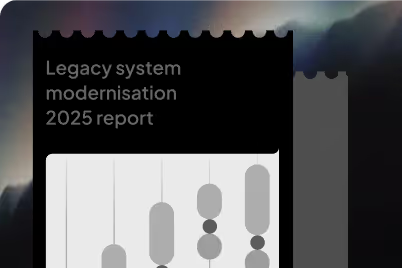Onshore Vs Offshore Software Development: Realistic Pros & Cons Comparison

The offshore software development market keeps growing, but here's what nobody tells you: those advertised savings rarely show up in your final invoice.
Offshore developer rates promise 40-60% cost cuts compared to onshore teams. Then reality hits. Management overhead inflates your budget. Communication tools need paying. Security infrastructure costs add up. Rework from timezone delays and miscommunication eats hours. That "cheap" offshore team suddenly costs far more than the rate sheet suggested.
Companies choosing between onshore vs offshore need honest numbers, not sales pitches. This breakdown shows your real development team costs using 2025 data from actual implementations.
You'll see what onshore development costs look like, where offshore pricing actually lands after hidden fees, and which model delivers better ROI for your specific budget and timeline.
What Separates Onshore vs Offshore Development in 2025
The onshore vs offshore debate starts with understanding what each model actually delivers. Here's how they differ in 2025.
A) Onshore Development Explained
Onshore development means hiring teams in your own country. The onshore vs offshore choice starts here: understanding what premium rates buy you. US companies pay onshore developers $75-200 per hour depending on experience level.
Here's what you get:
- Same timezone coordination: No midnight standup meetings or 12-hour response delays
- Zero language barriers: Direct communication without translation confusion
- Cultural alignment: Everyone understands your business context and work style
- Regulatory simplicity: Local IP laws and compliance requirements already match
Your team joins standup meetings without setting alarms for 3 AM calls. Questions get answered in minutes, not the next day. Code reviews happen in real-time.
The tradeoff? Onshore development costs run 60% higher than offshore alternatives. Hiring takes longer too: 60 to 90 days to fill senior positions because everyone competes for the same limited talent pool.
Right now, 74% of global employers struggle to find skilled tech workers, and 76% of those are specifically in IT.
B) Offshore Software Development Breakdown
Offshore software development moves your team to distant countries. India, Eastern Europe, and the Philippines dominate this space. The onshore vs offshore comparison shifts dramatically when you see offshore developer rates at $20-70 per hour.
The benefits stack up fast:
- Global talent pool access: India alone has 5.8 million developers ready to hire
- Faster team scaling: Build a team in 14-21 days versus months of local recruiting
- Cost reduction: Save 40-60% on base hourly rates compared to US hiring
- Staff augmentation success: The right model delivers 83% project success rates
You can hire specialists in blockchain, AI, or niche technologies that cost double locally. The onsite vs offshore debate centers on one question: can you manage timezone differences and build strong communication processes?
Smart companies choosing between onshore vs offshore focus on model selection first, location second. Get that right, and the offshore software development cost savings become real.
Real Costs: Onshore vs Offshore Developer Rates by Region
Offshore developer rates vary wildly by location. The onshore vs offshore pricing differences become clear when you compare actual 2025 numbers across regions.
1. North America
US onshore development costs stay at the top of the price range. Onshore teams charge $75-200 per hour. Silicon Valley senior developers pull $120,000-180,000 annually before benefits and overhead.
Canada runs slightly lower but still commands premium rates. Companies comparing onshore vs offshore options see the stark difference here.
2. Western Europe
Germany charges $50-199 per hour depending on the city. UK developers cost $60-120 per hour, with London at the high end. France, Belgium, and Ireland sit at $50-149 per hour.
Post-Brexit adjustments made British developers more competitive, but onshore development costs in Western Europe still exceed Eastern alternatives by 40-60%.
3. Eastern Europe
This region delivers the best cost-to-quality ratio for offshore software development. Poland, Romania, and the Czech Republic range from $25-80 per hour. Estonia commands premium rates at $50-99 per hour due to senior-level expertise.
Over 1.8 million tech professionals work here, offering up to 50% savings versus Western markets. The onshore vs offshore gap narrows slightly here, but savings remain substantial.
4. South Asia
India dominates software development outsourcing at $20-45 per hour. Bangalore and Hyderabad charge $30-45 per hour as premium hubs. Tier-2 cities like Pune cost $20-35 per hour.
The IT outsourcing market in India generates $12.72 billion in revenue for 2025. Here's why 54% of US companies choose India: massive talent pool and established infrastructure. Offshore developer rates here remain unbeatable.
5. Southeast Asia
Philippines excels at $25-45 per hour with 97% English proficiency. Vietnam offers $25-40 per hour as an emerging market. Malaysia sits at $30-50 per hour with strong infrastructure. These countries produce 200,000+ computer science graduates annually, feeding the global talent pool.
6. Latin America (Nearshore)
Nearshore development costs $30-85 per hour. You pay 10-30% more than Asian offshore rates but gain timezone alignment with US teams. The Latin American enterprise software market hit $14 billion in 2024, growing at 12.7% annually through 2030. Many companies find this sweet spot between onshore vs offshore tradeoffs.
The onsite vs offshore pricing gap remains substantial across all regions. Smart offshore software development choices let you access quality talent at 40-70% savings. Your development team costs depend heavily on which region matches your onsite vs offshore requirements and project complexity.
The Onshore Advantage: Why Companies Pay Premium Rates
Onshore development costs more for specific reasons. Here's what premium onshore vs offshore pricing actually buys you.
1. Zero Communication Friction
Onshore teams operate in your timezone. Same language. Same work culture. Same holidays.
You get real-time collaboration without waiting 12 hours for responses. Code reviews happen during your workday, not overnight. Standups feel natural at 9 AM instead of 9 PM.
Harvard found that just 1-hour time zone differences reduce real-time collaboration by 19%. The onshore vs offshore debate often centers on communication barriers: eliminate that gap entirely with onshore development.
Questions get answered in Slack within minutes. Problems get solved in quick calls, not email chains. Your team understands cultural context without explanation. Companies weighing onshore vs offshore options see this friction-free workflow as worth the premium.
2. Quality Control and Compliance
Onshore development costs more, but you get built-in regulatory alignment. Local IP laws protect your code automatically. HIPAA, SOC2, and GDPR compliance feels straightforward because everyone operates under the same rules.
Reduced rework rates matter too. Quality assurance happens faster when your QA team sits in the same legal jurisdiction. Security audits close quicker. Data residency requirements get met by default. Offshore security risks disappear when your code never leaves the country.
Financial services and healthcare companies often choose onshore vs offshore based purely on compliance complexity. The premium rates buy peace of mind over offshore software development complications.
3. The Drawbacks Nobody Talks About
Onsite projects cost 60% more than offshore alternatives. That price gap hurts when you're scaling fast. The onsite vs offshore calculation gets ugly when development team costs multiply.
Limited global talent pool access creates real problems:
- Hiring delays. Fill senior positions in 60-90 days versus 14-21 days with staff augmentation models
- Talent shortages. 74% of global employers struggle finding skilled workers; 76% are in IT
- Turnover costs. US tech companies lose 13.2-18.3% of top IT talent yearly
- Competition. Everyone fights for the same blockchain and AI specialists
You pay premium onshore development costs for developers who might leave in 18 months. The onshore vs offshore math changes fast when recruitment costs stack up. Niche skills like Kubernetes or machine learning cost double locally, if you can find them at all. Offshore developer rates suddenly look more attractive when local hiring fails repeatedly.
Offshore Software Development: Separating Hype from Reality
Offshore software development promises massive savings. Here's what actually happens when you move your team offshore.
1. The Cost Savings Promise
Offshore software development promises 40-60% cost reduction versus local hiring. Clients document these savings consistently when comparing onshore vs offshore base rates.
Build a complete team in 14-21 days instead of waiting months for local recruiting. Access 45 million professional developers projected globally by 2030. India alone offers 5.8 million developers ready to join your project.
Staff augmentation models push success rates to 83% when you pick the right partner. Offshore developer rates at $20-70 per hour versus $75-200 onshore create immediate budget relief. You hire specialists in blockchain, AI, or niche technologies that cost double in the US market.
2. Hidden Costs That Kill Your Budget
Here's where offshore software development pricing gets messy. Those advertised offshore developer rates multiply once reality hits.
3. Quality Perception Flipped in 2025
Offshore software development used to mean "cheaper but lower quality." Not anymore. The onshore vs offshore quality debate shifted completely. Model choice matters more than location.
Staff augmentation with dedicated teams beats project-based software development outsourcing every time. Offshore ROI depends on picking the right engagement model, not just the cheapest hourly rate.
Onsite vs Offshore: Which Model Wins for Your Project?
The onshore vs offshore choice depends on your budget, timeline, and project complexity. Here's how to decide.
1. Choose Onshore If:
- Budget exceeds $200K. Cost isn't your primary constraint
- Regulatory requirements. HIPAA, GDPR, SOC2 compliance complexity matters
- Daily collaboration needs. Face-to-face meetings drive your workflow
- Security-critical projects. Data residency requirements mandate local teams
- Immediate market launch. Zero time zone differences speed up delivery
Even regulated industries trust offshore software development now. The BFSI sector holds 24.3% of the offshore market, proving banks handle sensitive data offshore successfully.
2. Choose Offshore If:
- Budget-conscious. $50K-150K range needs 40-60% savings
- Clear requirements. Documented specifications minimize communication barriers
- Management investment. You'll build collaboration processes and invest in tools
- 3-6 month integration. Timeline accepts initial staff augmentation onboarding
- Scalability priority. Access global talent pool for rapid team growth
Offshore developer rates deliver 83% success rates with dedicated teams. Offshore ROI turns positive within 3-6 months despite month 1-2 showing 20% productivity dips.
3. Hybrid Approach (Most Popular)
64% of companies now use hybrid development model strategies. 92% of Global 2000 firms leverage some form of software development outsourcing.
The split works like this:
- Onshore teams. Architecture decisions, strategy, security-critical modules
- Offshore teams. Feature development, scaling, execution work
- Combined results. 20-30% productivity increase with digital collaboration tools
McKinsey data confirms this approach works. You get onshore control with offshore economics. The onsite vs offshore debate becomes obsolete when you blend both models strategically.
Your development team costs shrink while maintaining quality. The onshore vs offshore question transforms into "which partner executes our hybrid development model best?"
How Momentum91 Bridges the Onshore vs Offshore Gap
Momentum91 brings together deep AI, development, and design expertise to help you scale offshore software development quickly and efficiently. With 8 years of experience, a global infrastructure spanning 25 centres and 11 cities, and a talent pool of 13,000+ people, we deliver embedded, full-stack teams that feel like your own.
We move fast, with 95% of offshore teams going live in under ten weeks, and we cover everything from software development outsourcing PoC development to software roll-outs and UX strategy.
Key Strengths:
- Dedicated Team Model: Retention focus to avoid the 30-40% turnover trap. We achieve 92-95% retention rates through staff augmentation that prioritizes long-term partnerships over project churn.
- Transparent Pricing: No hidden management fees. Clear breakdown of development team costs and service fees so you know exactly what you pay.
- Overlapping Timezone Hours: Real-time collaboration capability to maximize the 20-30% productivity increase from effective collaboration tools. Minimize time zone differences impact.
- Proven Track Record: Faster time to hire (14-21 days), staff augmentation model for better offshore ROI. Access the global talent pool with India offshore costs that deliver 40-60% savings.
Get offshore cost savings without sacrificing onshore quality and communication standards. Momentum91 solves the onshore vs offshore tradeoff by delivering both.
Conclusion
The onshore vs offshore decision isn't about location anymore. It's about models and execution. Onshore offers predictability and zero friction. Offshore software development delivers cost savings when managed properly.
Most companies chase cheap offshore developer rates and ignore the real costs. They skip vetting for staff augmentation quality. They underestimate communication barriers and time zone differences.
Projects blow budgets from hidden fees. Developer turnover kills momentum. Teams need constant rebuilding instead of shipping features. Your offshore ROI never shows up because you picked price over process.
Success requires hybrid development model thinking, realistic timelines, managing project management overhead, and prioritizing retention over rates.
Momentum91 delivers staff augmentation with high retention. Transparent development team costs. Teams live in weeks, not months. You get offshore economics without sacrificing onshore quality.
Talk to our experts today and see how we bridge the onshore vs offshore gap for your project.
FAQs
1. Is offshore development cheaper than onshore in 2025?
Yes, but factor in hidden costs. Offshore developer rates run 40-60% lower than onshore development costs. Add project management overhead, communication barriers, and quality assurance offshore expenses. Real offshore software development savings land at 30-40% after development team costs compound. The onshore vs offshore gap narrows once you count everything.
2. What's the biggest risk with offshore software development?
Developer turnover destroys continuity. Traditional offshore software development models average 30-40% annual churn. Staff augmentation providers achieve 92-95% retention rates. Each replacement costs weeks of productivity and institutional knowledge. Choose partners prioritizing retention over rock-bottom offshore developer rates. The onshore vs offshore choice depends on model quality.
3. How long does offshore team integration take?
Expect 3-6 months for full productivity and positive offshore ROI. Month 1-2 shows onboarding dips. Month 3-4 reaches efficiency. Month 5-6 achieves strong output. Staff augmentation cuts hiring time to 14-21 days versus months locally. Onshore vs offshore integration speed depends on communication barriers management and time zone differences handling.
4. Can offshore teams handle complex projects in 2025?
Absolutely. Offshore software development quality matches onshore standards now. Teams run backend infrastructures, Kubernetes, microservices with high uptime. Companies trust offshore teams for production systems. Staff augmentation model matters more than location for offshore ROI. The onshore vs offshore quality debate ended. Offshore developer rates deliver enterprise-grade work.
5. What regions offer the best offshore value in 2025?
Eastern Europe developers deliver best cost-to-quality at competitive offshore developer rates. Philippines excels for English proficiency. India offshore costs offer largest global talent pool. Nearshore development in Latin America provides timezone advantages. The onshore vs offshore decision depends on development team costs, skills needed, and software development outsourcing priorities.
The inbox update you’ll never want to skip
A quick catch-up with ideas, wins, and tips worth stealing, straight to your inbox every week.
The easiest way to reach us.
Share your details and we’ll get back within 24 hours.
Blogs
A plethora of insights,all in one place
From strategy to execution. All the big ideas, practical guides & fresh perspectives that’ll help you scale with confidence
Ebooks
Comprehensive guides that break down the shifts in business and technology, Helping you lead with clarity.

Office Hours
Your direct line to our experts. Practical advice for scaling, right when you need it.

Reports
Data-backed perspectives on where industries are headed, giving you the foresight to make bolder moves.

Newsletter
A quick catch-up with ideas, wins, and tips worth stealing, straight to your inbox every week.
.avif)
Podcasts
Conversations where you get to know everything from the ones who know it best.
.avif)
Your Offshore Development Center, Done Right
Access top-tier global talent, enterprise infrastructure, and complete regulatory compliance through our proven model.
Start Now








